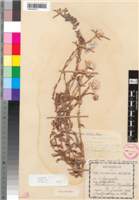Origin of name:
After Friedrich Wilms (1848-1919), apothecary of Berlin, who collected extensively in KwaZulu-Natal and Mpumalanga 1883-1896.
Diagnostic characters:
Large solitary headsBrown / white bractsBicoloured leaves
Description:
Soft-wooded subshrub, branches long, loose, straggling or sprawling, glandular-pubescent, white-cobwebby as well, particularly on young parts, leafy. Leaves mostly 12�30 x 3�9 mm, smaller and more distant upwards, narrowly panduriform to oblong becoming lanceolate-acuminate upwards, apex obtuse to acute, apiculate, base broad, more or less cordate-clasping, margins scarcely revolute, upper surface glandular-pubescent, sometimes greyish-white cobwebby as well, lower white-woolly or cobwebby. Heads heterogamous, campanulate, c. 13�20 mm long, nearly double that across the radiating bracts, solitary at the tips of long laxly leafy then bracteate branchlets. Involucral bracts in c. 10 series, graded, imbricate, inner much exceeding flowers, acute, glossy, outer pale or rich chestnut brown sometimes with a rosy overcast, inner white sometimes tinged rose. Receptacle shortly honeycombed. Flowers 219�483, 18�39 female, 188�445 homogamous. Achenes 0.75 mm long, glabrous. Pappus bristles many, equaling corolla, barbellate above, bases not cohering.
Flowering recorded between November and July, at its peak in April and May.
Distribution:
Forms straggling tangled clumps in rough rocky grassland and forest margin herbage. Ranges from Magoebaskloof and Woodbush in Limpopo south along the mountains to the Barberton Mountains and the mountains near Mbabane in Swaziland.
Savanna and Grassland Biomes.
Taxonomy:
Literature:
Helichrysum wilmsii Moeser in Bot. Jb. 44: 333 (1910); Compton, Fl. Swaziland 636 (1976).
Type:
Lectotype: Mpumalanga, between Spitzkop & Komati River, July 1884, Wilms 707 (E; G).
Synonym(s):
Vouchers:
Codd 7854 (PRE); Compton 25680 (NBG; PRE); Galpin 14613 (PRE); Hilliard & Burtt 14277 (E; K; M; NU; PRE; S).

_sml.jpg)
_sml.jpg)
_sml.jpg)
_sml.jpg)
_sml.jpg)
_sml.jpg)
_sml.jpg)
_sml.jpg)
